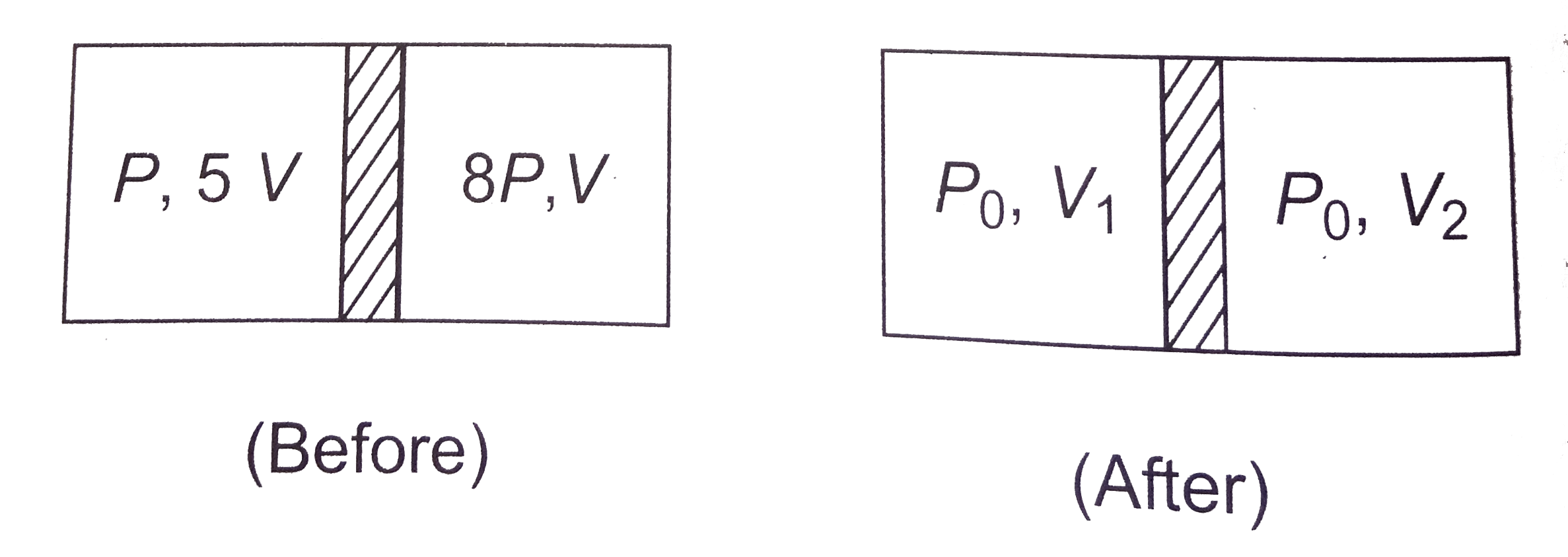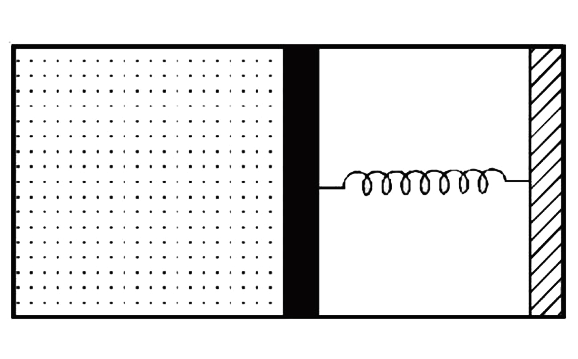A piston divides a closed gas cylinder into two parts. Initially the piston is kept pressed such that one part has a pressure P and volume 5V and the other part has pressure 8P and volume V, the piston is now left free. Find the new pressure and volume for the isothermal and aidabatic process. (γ=1.5)

P0 : common pressure
Isothermal process
Chamber 1: P.5V=P0V1
Chamber 2, 8P.V=P0V2
iii⇒58=V1V2⇒V2=85V1
V1+V2=5V+V
V1+85V1=6V⇒V1=30V13
V2=85V1=4813V
P.5V=P0V1⇒5PV=P03013
P0=136P
Adiabatic process:
P.(5V)γ=P0Vγ1
8P.(V)γ=P0Vγ2
iii⇒18(5)γ=(V1V2)γ⇒V1V2=5(18)1γ
V1V2=5(123)23=54
V2=45V1
V1+V2=5V+V⇒V1+45V1=6V⇒V1=103V
V2=45V1=45.103V
V2=45V1=45.103V=83V
P.(5V)γ=P0Vγ1⇒P0=P(5VV1)γ=P⎛⎝5V103V⎞⎠γ
P0=(32)32P=1.84P
Topper's Solved these Questions
Similar Questions
A closed gas cylinder is divided into two parts by a piston held tight. The pressure and volume of gas in two parts respectively are (P, 5V) and (10P, V). If now the piston is left free and the system undergoes isothermal process, then the volumes of the gas in two parts respectively are
View SolutionA masslesss piston divides a closed thermallyy insulated cylinder into two equal parts. One part contains M = 28 g of nitrogen. At this temperature, one-third of molecules are dissociated into atoms and the other part is evacuated. The piston is released and the gas fills the whole volume of the cylinder at temperature T0. Then, the piston is slowly displaced back to its initial position. calculate the increases in internal energy of the gas. Neglect further dissociation of molecules during, the motion of the piston.
View Solution
Knowledge Check
- Question 1 - Select One
A monatomic gas at a pressure P, having a volume V expands isothermally to a volume 2 V and then adiabatically to a volume 16 V. The final pressure of the gas is ( take γ=53)
A64 PB32 PCP64D16 P - Question 2 - Select One
A monatomic gas at a pressure P, having a volume V expands isothermally to a volume 2 V and then adiabatically to a volume 16 V. The final pressure of the gas is ( take γ=53)
A64 PB32 PCP/64D16 P - Question 3 - Select One
A monoatomic gas at a pressure P, having a volume V expands isothermally to a volume 2V and then adiabatically to a volume 16 V. The final pressure of the gas is (Take γ=5/3)
A64 PB32 PCP/64D16 P
A weightless piston divides a thermally insulated cylinder into two parts of volumes V and 3V.2 moles of an ideal gas at pressure P=2 atmosphere are confined to the part with volume V=1 litre. The remainder of the cylinder is evacuated. The piston is now released and the gas expands to fill the entire space of the cylinder. The piston is then pressed back to the initial position. Find the increase of internal energy in the process and final temperature of the gas. The ratio of the specific heats of the gas, γ=1.5.
View SolutionA monatomic gas at a pressure P, having a volume V expands isothermally to a volume 2 V and then adiabatically to a volume 16 V. The final pressure of the gas is ( take γ=53)
View SolutionA gas is filled in a cylinder with initial pressure P, initial volume V. When the pressure is increased by dP and volume reduces by dV. The bulk modulus is
View SolutionAn ideal monoatomic gas is confined in a horizontal cylinder by a spring loaded piston (as shown in the figure). Initially the gas is at temperature T1, pressure P1 and volume V1and the spring is in its relaxed state. The gas is tehn heated very slowly to temperature T2,pressure P2and volume V2. During this process the piston moves out by a distance x. Ignoring the friction between the piston and the cylinder, the correct statement (s) is (are)
 View Solution
View SolutionA monoatomic gas at a pressure p, having a volume 2V and then adiabatically to a volume 16 V. The final pressure of the gas is (take γ=53 )
View Solution

